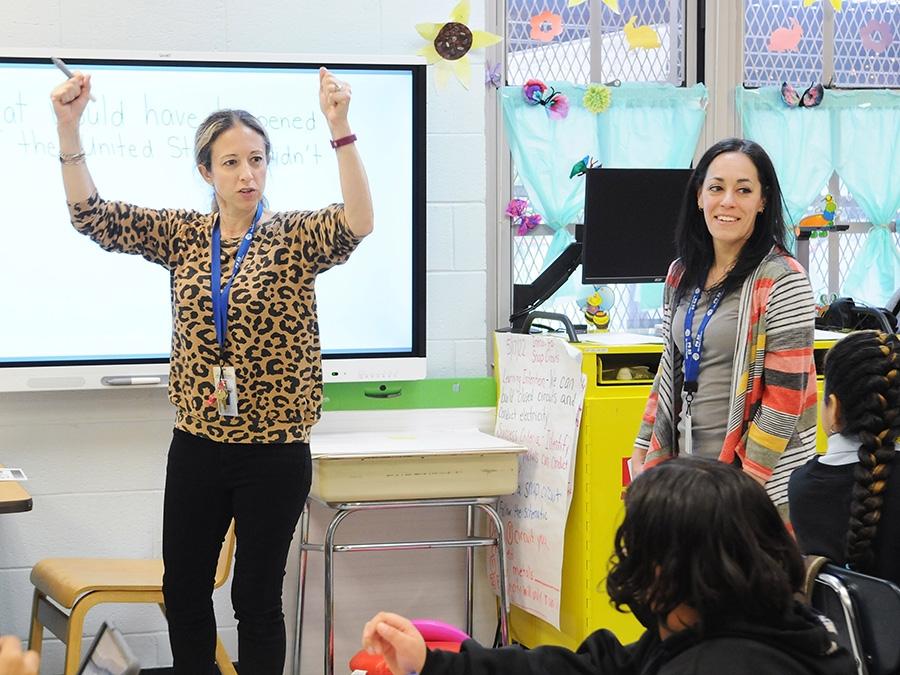
English as a New Language teacher Christine Passarelli (right) works closely with 4th-grade teacher Elissa Ventura to serve students at PS 22 on Staten Island.
When I began my teaching career in 2007, more than a quarter of the students at my Queens elementary school were English language learners. Each year, our school seemed to shift its strategy for English as a New Language instruction in a fresh attempt to best serve those students.
Sometimes our ENL teachers “pushed in” to classrooms during subjects like science and social studies, which were likely to have unfamiliar vocabulary. Sometimes they “pulled out” students in small groups. And sometimes they provided parallel instruction alongside the classroom teacher, usually in reading or writing.
Since 2015, when amendments to Part 154 of the Commissioner’s Regulations concerning ENL instruction went into effect, integrated co-teaching has become standard. In theory, integrated co-teaching allows English language learners to experience grade-level content instruction and language support in the same class.
But in practice, the educators in a joint working group formed by the UFT and the city Department of Education’s Division of Multilingual Learners say the integrated ENL model needs “the logistical structures to program co-teaching pairs appropriately and effectively [including] dedicated common and consistent co-planning time for strong classroom implementation.”
“I have seven different co-teachers,” says Jerry Stephens, an ENL teacher at Queens Vocational HS in Long Island City and a 26-year veteran teacher. “I can’t plan with seven people. It’s unattainable and unrealistic.”
That’s why the working group recently issued a set of recommendations regarding programming, co-planning and professional learning for ENL instruction. They discussed the possibility of setting a cap on the number of co-teaching partnerships any one ENL instructor can have and of programming dedicated co-planning time for each partnership.
Stephens notes that ENL teachers bring important expertise to classrooms.
“English language learners need a lot of hands-on work with language that really requires them to have a productive struggle with it, a lot of preloading and backtracking over text,” says Stephens.
To support that work with language, Stephens creates glossaries and vocabulary exercises for students. He also provides audio readings of written text because English language learners “need to hear and see language at the same time,” he says. He encourages students to double space when writing so he — and they — can make notes and revise their language several times.
The UFT has advocated for years for thoughtful guidelines governing ENL instruction. To that end, the New York State Education Department’s Office of Bilingual Education and World Languages recently released new guidance on ENL instruction in a series of topic briefs. The second brief draws important distinctions for teachers about what integrated ENL co-teaching is (“instruction with the intention of meeting both content and English language and literacy development goals simultaneously”) and is not (“an opportunity for a grade-level or content-area teacher to have a teaching assistant or helper in the class,” among other things).
“We’re not just people who come in and help out,” says Christine Passarelli, an ENL teacher at PS 22 on Staten Island. “We’re experts in our field.”
But Passarelli supports the ICT model for English language learners. “We have to remember that our ENL students are trying to learn another language and also learn the content for their grade,” she said. “If they’re constantly being separated from their class, they’re doing double catchup.”
Passarelli co-teaches with 4th- and 5th-grade teachers at her school. Because she’s able to plan lessons with her co-teachers during common planning periods, she’s familiar with the curriculum and is able to anticipate how she’ll support English language learners.
“I’ll look at the lesson plan and think, what scaffolds are we going to bring in?” she says. “Language frames? More visuals? A word bank?”
On a recent morning, Passarelli joined 4th-grade teacher Elissa Ventura for a literacy lesson on the Declaration of Independence. Each teacher worked with a small group of students that included both English language learners and native English speakers. Passarelli and Ventura confer frequently to ensure their groups are fluid and reflect students’ current needs.
Both teachers taught the same content with subtle differences. Passarelli spent more time reviewing the vocabulary in the word bank before reading the text, encouraging students to mimic a hand gesture for the word “abolish.” She also provided students with sentence starters and frames to help them answer the question, “Why was the Declaration of Independence written?”
“Before you write, I want you to orally tell me what you plan to write,” Passarelli told her students. “It’s important to say it in your own words.”
Passarelli is hopeful that the working group’s recommendations will help more teachers and administrators understand what true ENL integrated co-teaching can achieve.
“Once we started doing more true co-teaching, keeping English language learners in their classrooms with access to two teachers who can support them alongside their native English-speaking peers, we’ve seen their enthusiasm for learning is heightened and they acquire more knowledge,” she says.